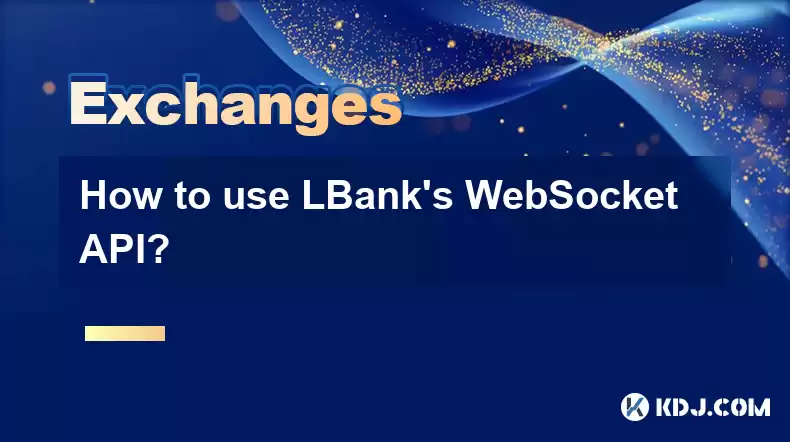-
 bitcoin
bitcoin $87959.907984 USD
1.34% -
 ethereum
ethereum $2920.497338 USD
3.04% -
 tether
tether $0.999775 USD
0.00% -
 xrp
xrp $2.237324 USD
8.12% -
 bnb
bnb $860.243768 USD
0.90% -
 solana
solana $138.089498 USD
5.43% -
 usd-coin
usd-coin $0.999807 USD
0.01% -
 tron
tron $0.272801 USD
-1.53% -
 dogecoin
dogecoin $0.150904 USD
2.96% -
 cardano
cardano $0.421635 USD
1.97% -
 hyperliquid
hyperliquid $32.152445 USD
2.23% -
 bitcoin-cash
bitcoin-cash $533.301069 USD
-1.94% -
 chainlink
chainlink $12.953417 USD
2.68% -
 unus-sed-leo
unus-sed-leo $9.535951 USD
0.73% -
 zcash
zcash $521.483386 USD
-2.87%
How to use LBank's WebSocket API?
LBank's WebSocket API enables real-time data integration and efficient trading; this guide helps set up and use it for market updates and order placement.
Apr 29, 2025 at 09:14 am

Using LBank's WebSocket API can be an effective way to receive real-time data and execute trades more efficiently. This article will guide you through the process of setting up and using the WebSocket API provided by LBank, a popular cryptocurrency exchange. By following this detailed guide, you'll be able to integrate real-time market data and trading capabilities into your applications.
Understanding WebSocket API Basics
Before diving into the specifics of LBank's WebSocket API, it's important to understand what a WebSocket API is and how it differs from traditional HTTP requests. WebSocket APIs provide a full-duplex communication channel over a single TCP connection, allowing for real-time data transfer between the client and the server. This is particularly useful in the cryptocurrency trading space, where timely updates can be crucial.
LBank's WebSocket API allows users to subscribe to real-time market data, such as price updates, order book changes, and trade executions. To start using the API, you'll need to establish a WebSocket connection to LBank's server.
Setting Up the WebSocket Connection
To begin, you need to establish a connection to LBank's WebSocket server. Here's how you can do it:
- Choose a WebSocket Library: You'll need a WebSocket library for your programming language. Popular choices include
websocket-clientfor Python,wsfor Node.js, andWebSocketfor Java. - Connect to the Server: The WebSocket endpoint for LBank is
wss://api.lbkex.com/ws. Use your chosen library to establish a connection to this endpoint.
Here's an example in Python using the websocket-client library:
import websocket
def on_open(ws):
print('Opened connection')
def on_message(ws, message):
print(message)
def on_error(ws, error):
print(error)
def on_close(ws, close_status_code, close_msg):
print('Closed connection')
if name == '__main__':
websocket.enableTrace(True)
ws = websocket.WebSocketApp('wss://api.lbkex.com/ws',
on_open=on_open,
on_message=on_message,
on_error=on_error,
on_close=on_close)
ws.run_forever()
Subscribing to Market Data
Once the connection is established, you can subscribe to various types of market data. LBank's WebSocket API supports several types of subscriptions, including:
- Ticker Data: Real-time price updates for specific trading pairs.
- Order Book Data: Real-time updates on the current state of the order book.
- Trade Data: Real-time updates on executed trades.
To subscribe to these data streams, you need to send a JSON-formatted message to the WebSocket server. Here's how to subscribe to ticker data for the BTC/USDT pair:
{
'sub': 'market.btcusdt.ticker', 'id': '12345'}
Send this message through your WebSocket connection:
ws.send(json.dumps({
'sub': 'market.btcusdt.ticker',
'id': '12345'
}))
You will receive ticker data in real-time, which you can handle in the on_message function.
Handling Received Data
When you receive data from the WebSocket API, it will be in JSON format. Here's an example of how you might handle ticker data:
import json
def on_message(ws, message):
data = json.loads(message)
if 'ch' in data and data['ch'] == 'market.btcusdt.ticker':
ticker = data['tick']
print(f'Latest Price: {ticker['close']}')
print(f'24h Volume: {ticker['vol']}')
This code parses the JSON message and extracts the latest price and 24-hour trading volume for the BTC/USDT pair.
Placing Orders via WebSocket
LBank's WebSocket API also allows you to place orders directly. To do this, you need to authenticate your connection and then send the appropriate JSON message. Here's how to do it:
- Authenticate: Send an authentication message with your API key and signature.
- Place an Order: Send an order message with the necessary parameters.
Here's an example of how to authenticate and place a buy order:
import hmac
import timeimport json
api_key = 'YOUR_API_KEY'api_secret = 'YOUR_API_SECRET'
def get_signature(timestamp, method, request_path, body):
payload = timestamp + method + request_path + (body or '')
return hmac.new(api_secret.encode('utf-8'), payload.encode('utf-8'), digestmod='sha256').hexdigest()
def authenticate(ws):
timestamp = str(int(time.time() * 1000))
signature = get_signature(timestamp, 'GET', '/users/self/verify', '')
auth_message = {
'op': 'auth',
'args': [api_key, timestamp, signature]
}
ws.send(json.dumps(auth_message))
def place_order(ws):
order_message = {
'op': 'order',
'args': [{
'symbol': 'btcusdt',
'type': 'buy',
'price': '30000',
'amount': '0.01'
}]
}
ws.send(json.dumps(order_message))
if name == '__main__':
websocket.enableTrace(True)
ws = websocket.WebSocketApp('wss://api.lbkex.com/ws',
on_open=lambda ws: (authenticate(ws), place_order(ws)),
on_message=on_message,
on_error=on_error,
on_close=on_close)
ws.run_forever()
This code authenticates the connection and then places a buy order for 0.01 BTC at a price of 30,000 USDT.
Unsubscribing from Market Data
If you need to stop receiving updates for a particular data stream, you can unsubscribe by sending an unsubscribe message. Here's how to unsubscribe from the ticker data for the BTC/USDT pair:
{
'unsub': 'market.btcusdt.ticker', 'id': '12345'}
Send this message through your WebSocket connection:
ws.send(json.dumps({
'unsub': 'market.btcusdt.ticker',
'id': '12345'
}))
FAQs
Q: Can I use LBank's WebSocket API for multiple trading pairs simultaneously?A: Yes, you can subscribe to multiple trading pairs by sending separate subscription messages for each pair. For example, to subscribe to both BTC/USDT and ETH/USDT ticker data, you would send:
{ 'sub': 'market.btcusdt.ticker', 'id': '12345'}and
{ 'sub': 'market.ethusdt.ticker', 'id': '12346'}A: If the WebSocket connection drops, your application should attempt to reconnect automatically. You can implement a reconnection mechanism in your code to handle this scenario. For example, in Python:
import time
def on_error(ws, error):
print(error)
time.sleep(5) # Wait for 5 seconds before attempting to reconnect
ws.run_forever()
def on_close(ws, close_status_code, close_msg):
print('Closed connection')
time.sleep(5) # Wait for 5 seconds before attempting to reconnect
ws.run_forever()
Q: How can I ensure the security of my API key when using the WebSocket API? A: To ensure the security of your API key, never hardcode it into your script. Instead, use environment variables or a secure configuration file to store your API key and secret. Additionally, always use HTTPS (wss://) for WebSocket connections to encrypt your data in transit.
Disclaimer:info@kdj.com
The information provided is not trading advice. kdj.com does not assume any responsibility for any investments made based on the information provided in this article. Cryptocurrencies are highly volatile and it is highly recommended that you invest with caution after thorough research!
If you believe that the content used on this website infringes your copyright, please contact us immediately (info@kdj.com) and we will delete it promptly.
- COIN's Compass: Coinbase Stock Market Performance Charting New Territories Amidst Evolving Crypto Landscape
- 2025-12-20 12:45:01
- GeeFi Rockets Towards 100x Returns, While Ripple Makes Strategic Stablecoin Moves
- 2025-12-20 06:15:02
- Big City Crypto Buzz: Cross-Chain Bridges, Multi-Chain Horizons, and Presales Paving the Future
- 2025-12-19 21:45:01
- Ray Dalio's Portfolio Prescription: Why Bitcoin and Gold Are Essential in a Debt-Ridden World
- 2025-12-19 01:35:01
- Taiwan's Bitcoin Trove: Criminal Investigations Unearth a Surprising Global Ranking
- 2025-12-19 01:30:02
- Coinbase's Bold Leap: Stocks, Prediction Markets, and the Future of Trading
- 2025-12-19 01:35:01
Related knowledge

What does it mean to "Hedge" a position on Bybit and how do I do it?
Dec 11,2025 at 07:00pm
Understanding Position Hedging on Bybit1. Hedging on Bybit refers to opening opposing positions in the same trading pair to reduce exposure to adverse...

How to secure my Bybit account against phishing and scams?
Dec 12,2025 at 11:39am
Enable Two-Factor Authentication (2FA)1. Log in to your Bybit account and navigate to the Security Settings section. 2. Select Google Authenticator or...

Why is the price mark on Bybit different from the last traded price?
Dec 17,2025 at 07:19am
Price Mark Mechanism on Bybit1. Bybit uses a mark price rather than the last traded price to calculate unrealized P&L and determine liquidation events...

How does Bybit's VIP program work and what are the benefits?
Dec 18,2025 at 05:00pm
Structure of Bybit VIP Program1. The Bybit VIP program categorizes users into tiers based on their 30-day average net asset value and trading volume a...

What is the "Reduce-Only" option on Bybit and how does it prevent accidental orders?
Dec 15,2025 at 10:40am
Understanding Reduce-Only Mode1. Reduce-Only is a risk control feature on Bybit that restricts order execution to positions that only decrease or clos...

How to convert small balances ("dust") to another coin on Bybit?
Dec 07,2025 at 08:59pm
Understanding Dust Conversion on Bybit1. Dust refers to tiny, non-withdrawable balances of cryptocurrencies left in a user’s spot wallet after partial...

What does it mean to "Hedge" a position on Bybit and how do I do it?
Dec 11,2025 at 07:00pm
Understanding Position Hedging on Bybit1. Hedging on Bybit refers to opening opposing positions in the same trading pair to reduce exposure to adverse...

How to secure my Bybit account against phishing and scams?
Dec 12,2025 at 11:39am
Enable Two-Factor Authentication (2FA)1. Log in to your Bybit account and navigate to the Security Settings section. 2. Select Google Authenticator or...

Why is the price mark on Bybit different from the last traded price?
Dec 17,2025 at 07:19am
Price Mark Mechanism on Bybit1. Bybit uses a mark price rather than the last traded price to calculate unrealized P&L and determine liquidation events...

How does Bybit's VIP program work and what are the benefits?
Dec 18,2025 at 05:00pm
Structure of Bybit VIP Program1. The Bybit VIP program categorizes users into tiers based on their 30-day average net asset value and trading volume a...

What is the "Reduce-Only" option on Bybit and how does it prevent accidental orders?
Dec 15,2025 at 10:40am
Understanding Reduce-Only Mode1. Reduce-Only is a risk control feature on Bybit that restricts order execution to positions that only decrease or clos...

How to convert small balances ("dust") to another coin on Bybit?
Dec 07,2025 at 08:59pm
Understanding Dust Conversion on Bybit1. Dust refers to tiny, non-withdrawable balances of cryptocurrencies left in a user’s spot wallet after partial...
See all articles









































































